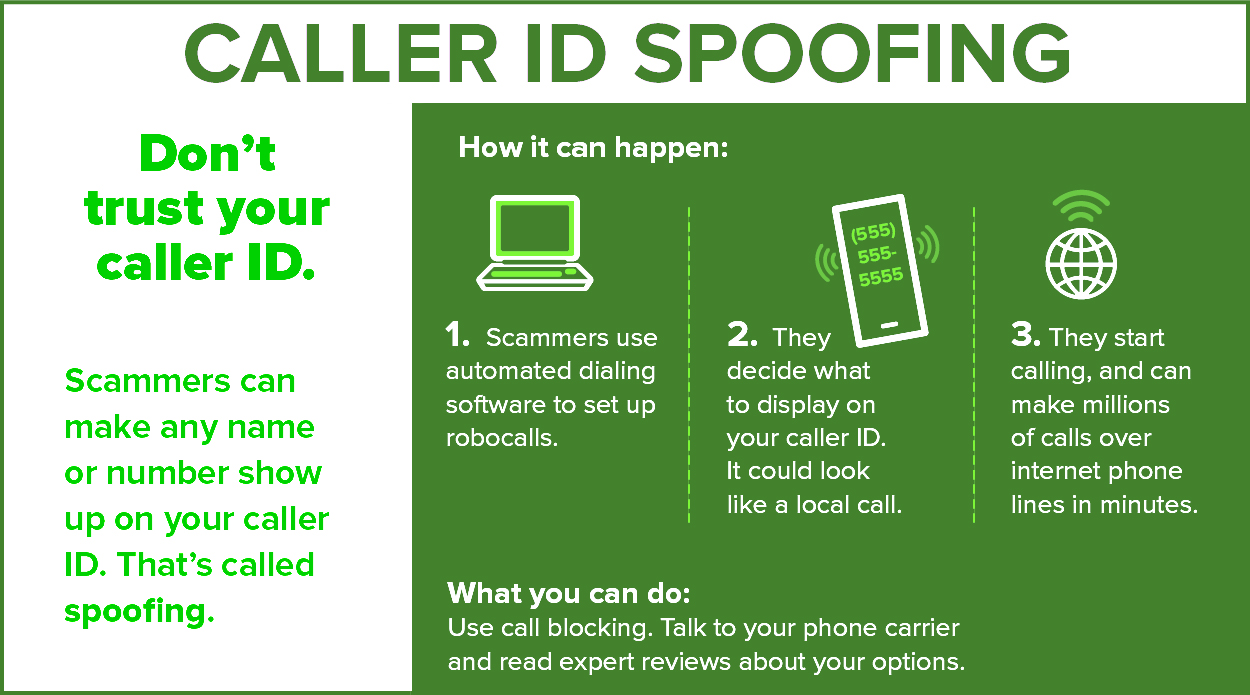Your phone rings. You recognize the number, but when you pick up, it’s someone else. What’s the deal?
Scammers are using fake caller ID information to trick you into thinking they are someone local, someone you trust — like a government agency or police department, or a company you do business with — like your bank or cable provider. The practice is called caller ID spoofing, and scammers don’t care whose phone number they use.
Don’t rely on caller ID to verify who’s calling. It can be nearly impossible to tell whether the caller ID information is real. Here are a few tips for handling these calls:
- If you get a strange call from the government, hang up. If you want to check it out, visit the official (.gov) website for contact information. Government employees won’t call out of the blue to demand money or account information.
- Don’t give out — or confirm — your personal or financial information to someone who calls.
- Don’t wire money or send money using a reloadable card. In fact, never pay someone who calls out of the blue, even if the name or number on the caller ID looks legit.
- Feeling pressured to act immediately? Hang up. That’s a sure sign of a scam.

If you receive a call that appears to come from your own name and telephone number, you should take the following steps:
- Report the call to your phone company, which may be able to offer calling features that block unwanted calls.
- Report the call to the Federal Trade Commission (FTC) and the Federal Communications Commission (FCC). These agencies have the authority to enforce federal laws that regulate caller ID spoofing, as well as autodialed and prerecorded message calls. The FCC can also impose fines on individuals and entities that violate those laws.
- Report the call to the Public Utilities Commission (PUC) in your state. The PUC has authority over local telephone services like caller ID. It is very important that the PUC hear from citizens affected by caller ID spoofing.
- If you lost money to a criminal scam, report the matter to your local police or county sheriff or the FBI. These agencies have the authority to investigate and prosecute criminal matters.

The FCC is also warning about robocallers who ring up targets, then abruptly hang up. Those who call back are connected to a number that charges by the minute. It’s known as a “Wangiri” scam, Japanese for one-ring-and-cut.
These calls are likely trying to prompt you to call the number back, often resulting in per minute toll charges, similar to a 900 number. It is advised you should not call these numbers back.
To the unsuspecting person, the one-ring calls appear to be from someone in the United States, because the phone numbers begin with three digits that resemble American area codes. But the FCC says the scammers are using international numbers whose country codes also begin with three digits, making it easier to trick people.
To avoid becoming a victim, don’t answer or return calls from an unfamiliar number and check whether an area code is international before calling a new number. Always be cautious, even if a number appears authentic.
If you fall victim to the one-ring scammers and get billed, you might want to ask your phone provider to wipe away the fee. If that doesn’t work, file a complaint with the FCC.
One of the reasons service providers haven’t been able to stop all these seemingly random phone calls is that scam call detection is inherently complex.
Determining that an incoming call is fake requires that massive data sets be analyzed in real time to spot anomalies. Some less sophisticated scam detection algorithms are easier for fraudsters to get by because they look at smaller data sets.
Also, the process of removing a valid caller’s number from a network’s scammer list can be slow, triggering false positives on legitimate numbers in the meantime.

